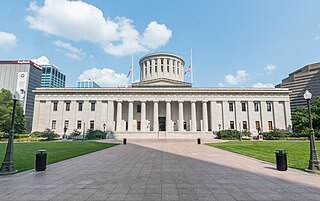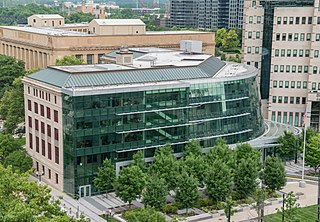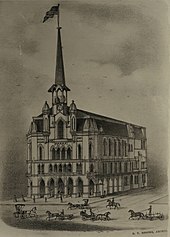
The City Hall-County Building, commonly known as City Hall, is a 12-story building in Chicago, Illinois that houses the seats of government of the City of Chicago and Cook County. The building's west side holds the offices of the mayor, city clerk, and city treasurer; some city departments; offices of alderpersons of Chicago's 50 wards; and the Chicago City Council's chambers. The building's east side houses offices of the Government of Cook County, including the Cook County Board of Commissioners' chambers.

The Ohio Statehouse is the state capitol building and seat of government for the U.S. state of Ohio. The Greek Revival building is located on Capitol Square in Downtown Columbus. The capitol houses the Ohio General Assembly, consisting of the House of Representatives and the Senate. It also contains the ceremonial offices of the governor, lieutenant governor, state treasurer, and state auditor. Built between 1839 and 1861, it is one of the oldest working statehouses in the United States. The statehouse grounds include two other buildings, the Judiciary Annex or Senate Building, and the Atrium; the three are collectively referred to as the Ohio Statehouse into the present day.

North Market is a food hall and public market in Columbus, Ohio. The Downtown Columbus market was established in 1876, and was the second of four founded in Columbus. The market is managed by the non-profit North Market Development Authority (NDMA), which also manages North Market Bridge Park, a market in Dublin, Ohio.

The Columbus Metropolitan Library (CML) is a public library system in Franklin County, Ohio, in the Columbus metropolitan area. The library serves an area of 872,000 residents, has a collection of 1,483,433 volumes, and circulates 17,262,267 items per year.

Engine House No. 12 is a former fire station in the Olde Towne East neighborhood of Columbus, Ohio. Today it primarily houses Gemüt Biergarten, a German restaurant, brewery, and biergarten, with its second story used for offices. It is a contributing property to the Columbus Near East Side District, a national historic district established in 1978.

The Alexandria City Hall also known as the Alexandria Market House & City Hall, in Alexandria, Virginia, is a building built in 1871 and designed by Adolph Cluss. In 1984, the building was listed on the U.S. National Register of Historic Places.

The Ohio History Center is a history museum and research center in Columbus, Ohio. It is the primary museum for Ohio's history, and is the headquarters, offices, and library of the Ohio History Connection. The building also houses Ohio's state archives, also managed by the Ohio History Connection. The museum is located at the Ohio State Fairgrounds, site of the Ohio State Fair, and a short distance north of downtown. The history center opened in 1970 as the Ohio Historical Center, moving the museum from its former site by the Ohio State University. The building was designed by Ireland & Associates in the Brutalist style. It was listed on the National Register of Historic Places along with the Ohio Village in 2023.

Columbus City Hall is the city hall of Columbus, Ohio, in the city's downtown Civic Center. It contains the offices of the city's mayor, auditor, and treasurer, and the offices and chambers of Columbus City Council.

The Toledo and Ohio Central Railroad Station, today named Station 67, is a union meeting space and event hall located in Franklinton, near Downtown Columbus, Ohio. Built by the Toledo and Ohio Central Railroad from 1895 to 1896, it served as a passenger station until 1930. It served as an office and shelter for Volunteers of America from 1931 to 2003, and has been the headquarters of International Association of Fire Fighters Local 67, a firefighters' union, since 2007. The building was placed on the National Register of Historic Places in 1973. During its history, the building has experienced fires and floods, though its relatively few owners have each made repairs and renovations to preserve the building's integrity. The building is the last remaining train station in Columbus.

The Delaware Public Library is a former public library in Delaware, Ohio. The building was funded by Andrew Carnegie and built in the neoclassical style. It opened to the public in 1906. The library's collection of books and volumes rapidly expanded during its operational history. By the 1970s, the Delaware Public Library started to run out of space. In 1984, a new public library was constructed, and Delaware County, Ohio started using the Delaware Public Library for office space. The building was tripled in size during a construction and restoration project that lasted from 1999 to 2001. The Delaware Public Library is currently used to house a number of Delaware County agencies, including the Delaware County Board of Commissioners.

The Main Library of the Columbus Metropolitan Library (CML) system is located in Downtown Columbus, Ohio, United States. The public library is the largest in the library system and holds approximately 300,000 volumes. It includes numerous rooms, including separate spaces for children, teens, an adult reading room, newspaper room, auditorium, gallery, gift shop, and a cafe. The third floor includes a computer lab and houses the Franklin County Genealogical & Historical Society.

The George Floyd protests were a series of protests and civil disturbances that initially started in the Minneapolis–Saint Paul metropolitan area of Minnesota, United States, before spreading nationwide. In Columbus, Ohio, unrest began on May 28, 2020, two days after incidents began in Minneapolis. The events were a reaction to the murder of George Floyd by Minneapolis Police Department (MPD) officer Derek Chauvin, who knelt on Floyd's neck for over nine minutes, asphyxiating him.

The Michael B. Coleman Government Center is a municipal office building of Columbus, Ohio, in the city's downtown Civic Center. The building, completed in 2018, is named for former mayor Michael Coleman.

The government of Columbus, Ohio, headquartered at Columbus City Hall in Downtown Columbus, is organized into a mayor-council system. The mayor is responsible for the administration of city government. The Columbus City Council is a unicameral body consisting of nine members elected or appointed at-large. The city has numerous government agencies, responsible for public education, health, and safety; emergency services; recreational facilities; sanitation; water supply; and welfare services.

Central Market was a public market in Downtown Columbus, Ohio. The market operated from 1814 to 1966, was the location of Columbus's first city hall for two decades, from 1850 to 1872. It moved three times, each time into successively larger buildings. The third market building stood the longest time, from 1850 to 1966, when it was demolished as part of the Market-Mohawk Urban Renewal project. North Market remains, the only one left of four public markets that operated in the city.

77 North Front Street is a municipal office building of Columbus, Ohio, in the city's downtown Civic Center. The building, originally built as the Central Police Station in 1930, operated in that function until 1991. After about two decades of vacancy, the structure was renovated for city agency use in 2011.

Engine House No. 10 is a Columbus Division of Fire station in the Franklinton neighborhood of Columbus, Ohio. The original firehouse was built in 1897, while its neighboring replacement, also known as Station 10, was completed in 2008.

Brubaker/Brandt was an architecture firm based in Columbus, Ohio. The firm completed some of the tallest buildings affecting the city's skyline including the 42-story Rhodes State Office Tower and the Continental Center, along with other notable buildings throughout the Columbus area.

The Columbus City Prison was a municipal prison in Downtown Columbus, Ohio. The building was constructed in 1879 in a castle-like style, designed by architect George H. Maetzel. The building served as a prison and headquarters of the Columbus Police Department until a fire demolished the structure in 1920.

The Columbus Public School Library was a two-story building in Downtown Columbus, Ohio. It operated as the school library and administrative offices for the Columbus Public School District from 1892 to 1912. The library was established in the former First Methodist Episcopal Church, built in 1853 and extensively renovated for the district's use. The library opened in April 1892 and its ceiling collapsed in September 1912, leading to the building's demolition in 1913.


























